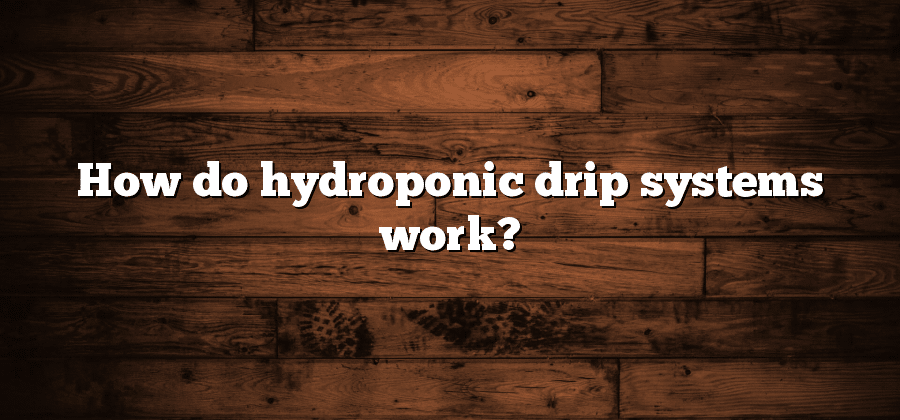What Are Hydroponic Drip Systems?
Hydroponic drip systems are a type of hydroponic system that utilize a drip irrigation method to deliver water and nutrients directly to the plants’ root systems. Unlike traditional soil-based gardening, hydroponic drip systems rely on a carefully regulated mixture of water and nutrients, which are constantly delivered to the plants through a network of tubes and emitters.
These systems consist of several components, including a nutrient reservoir, a water pump, tubing, and drip emitters. The nutrient reservoir holds the nutrient solution, which is a mixture of water and essential nutrients required for plant growth. The water pump pushes the nutrient solution through the tubing and drips it onto the plants’ roots through the emitters. This controlled delivery system ensures that the plants receive the necessary moisture and nutrients in precise quantities, minimizing waste and optimizing growth.
The Components of Hydroponic Drip Systems
A hydroponic drip system is composed of several crucial components that work together seamlessly to ensure the efficient delivery of nutrients and water to plants. One of the key elements is the reservoir, which serves as the central storage for the nutrient solution. It is typically made of sturdy materials such as plastic or concrete and equipped with a lid to prevent contamination. The reservoir is connected to the distribution system, which consists of tubes, pipes, or hoses that carry the nutrient solution to the plants. These distribution lines are often made of durable materials like PVC or polyethylene to ensure longevity. Additionally, the drip emitters or microsprinklers play a vital role in regulating the flow of the nutrient solution and distributing it evenly to the plants. These components can be adjusted to control the amount and frequency of water delivery, allowing for precise nutrient management.
Another essential component of a hydroponic drip system is the timer or controller. This device is responsible for automating the irrigation process by determining when and how long the nutrient solution is delivered to the plants. It helps maintain consistency in feeding intervals, ensuring plants receive the required nutrients at the appropriate times. In more advanced systems, these timers can be programmed to account for different growth stages of plants or even adjust based on environmental conditions. Moreover, a filter is often included to remove any debris or impurities from the nutrient solution before it reaches the plants. This ensures a clean and healthy supply of nutrients, preventing clogging or damage to the system. Overall, the combination of these components forms a reliable hydroponic drip system that optimizes nutrient delivery and promotes plant growth.
The Role of Nutrient Solutions in Drip Systems
Hydroponic drip systems rely on nutrient solutions to provide essential elements for plant growth and development. These solutions, composed of a carefully balanced combination of nutrients, are delivered directly to the plants’ roots through a network of tubes and drippers.
The nutrient solutions used in drip systems are specifically formulated to meet the precise needs of different plant species. They contain a range of macronutrients, such as nitrogen, phosphorus, and potassium, as well as essential micronutrients like iron, zinc, and copper. These nutrients are dissolved in water, creating a solution that can be easily absorbed by the plants. By delivering the nutrients directly to the root zone, drip systems ensure that plants receive the optimal amount of nutrients, maximizing their growth potential. Additionally, the ability to adjust and fine-tune the composition of the nutrient solution enables growers to tailor the nutrient supply to the specific requirements of different crops, resulting in healthier and more productive plants.
The Importance of pH and EC Levels in Hydroponic Drip Systems
Hydroponic drip systems rely on precise pH and EC levels to ensure optimal plant growth and nutrient uptake. pH refers to the acidity or alkalinity of the nutrient solution, while EC (electrical conductivity) measures the concentration of dissolved salts. Understanding and maintaining these levels is crucial for a successful hydroponic operation.
Maintaining the correct pH is essential because it directly affects the availability of nutrients to plants. Different plants have specific pH preferences, so it’s crucial to adjust the nutrient solution accordingly. When the pH is too high or too low, certain nutrients become less available, leading to deficiencies or toxicities. Hence, regular monitoring and adjustment of pH levels are necessary to provide plants with the ideal conditions for growth and development. Similarly, monitoring EC levels is crucial as it helps ensure that the nutrient solution contains the appropriate amount of dissolved salts. This measurement indicates the strength of the nutrient solution and provides insight into how much fertilizer is present. By monitoring EC levels, growers can adjust the nutrient concentration to match the specific needs of their plants, promoting optimal nutrient uptake and avoiding potential nutrient imbalances.






